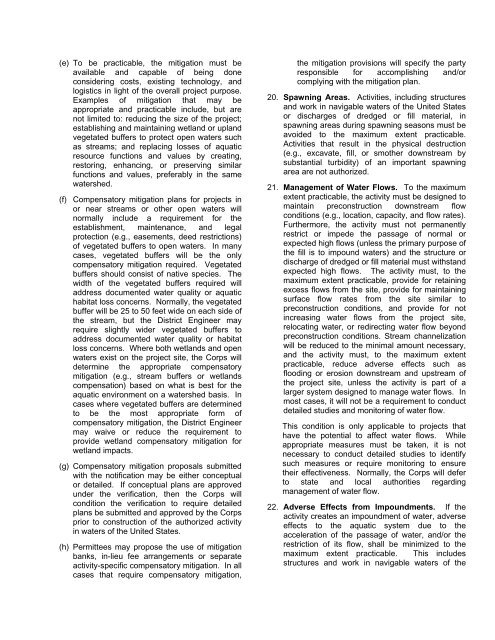Nationwide Permit 14 Summary - Nebraska Department of Roads
Nationwide Permit 14 Summary - Nebraska Department of Roads
Nationwide Permit 14 Summary - Nebraska Department of Roads
Create successful ePaper yourself
Turn your PDF publications into a flip-book with our unique Google optimized e-Paper software.
(e) To be practicable, the mitigation must beavailable and capable <strong>of</strong> being doneconsidering costs, existing technology, andlogistics in light <strong>of</strong> the overall project purpose.Examples <strong>of</strong> mitigation that may beappropriate and practicable include, but arenot limited to: reducing the size <strong>of</strong> the project;establishing and maintaining wetland or uplandvegetated buffers to protect open waters suchas streams; and replacing losses <strong>of</strong> aquaticresource functions and values by creating,restoring, enhancing, or preserving similarfunctions and values, preferably in the samewatershed.(f) Compensatory mitigation plans for projects inor near streams or other open waters willnormally include a requirement for theestablishment, maintenance, and legalprotection (e.g., easements, deed restrictions)<strong>of</strong> vegetated buffers to open waters. In manycases, vegetated buffers will be the onlycompensatory mitigation required. Vegetatedbuffers should consist <strong>of</strong> native species. Thewidth <strong>of</strong> the vegetated buffers required willaddress documented water quality or aquatichabitat loss concerns. Normally, the vegetatedbuffer will be 25 to 50 feet wide on each side <strong>of</strong>the stream, but the District Engineer mayrequire slightly wider vegetated buffers toaddress documented water quality or habitatloss concerns. Where both wetlands and openwaters exist on the project site, the Corps willdetermine the appropriate compensatorymitigation (e.g., stream buffers or wetlandscompensation) based on what is best for theaquatic environment on a watershed basis. Incases where vegetated buffers are determinedto be the most appropriate form <strong>of</strong>compensatory mitigation, the District Engineermay waive or reduce the requirement toprovide wetland compensatory mitigation forwetland impacts.(g) Compensatory mitigation proposals submittedwith the notification may be either conceptualor detailed. If conceptual plans are approvedunder the verification, then the Corps willcondition the verification to require detailedplans be submitted and approved by the Corpsprior to construction <strong>of</strong> the authorized activityin waters <strong>of</strong> the United States.(h) <strong>Permit</strong>tees may propose the use <strong>of</strong> mitigationbanks, in-lieu fee arrangements or separateactivity-specific compensatory mitigation. In allcases that require compensatory mitigation,the mitigation provisions will specify the partyresponsible for accomplishing and/orcomplying with the mitigation plan.20. Spawning Areas. Activities, including structuresand work in navigable waters <strong>of</strong> the United Statesor discharges <strong>of</strong> dredged or fill material, inspawning areas during spawning seasons must beavoided to the maximum extent practicable.Activities that result in the physical destruction(e.g., excavate, fill, or smother downstream bysubstantial turbidity) <strong>of</strong> an important spawningarea are not authorized.21. Management <strong>of</strong> Water Flows. To the maximumextent practicable, the activity must be designed tomaintain preconstruction downstream flowconditions (e.g., location, capacity, and flow rates).Furthermore, the activity must not permanentlyrestrict or impede the passage <strong>of</strong> normal orexpected high flows (unless the primary purpose <strong>of</strong>the fill is to impound waters) and the structure ordischarge <strong>of</strong> dredged or fill material must withstandexpected high flows. The activity must, to themaximum extent practicable, provide for retainingexcess flows from the site, provide for maintainingsurface flow rates from the site similar topreconstruction conditions, and provide for notincreasing water flows from the project site,relocating water, or redirecting water flow beyondpreconstruction conditions. Stream channelizationwill be reduced to the minimal amount necessary,and the activity must, to the maximum extentpracticable, reduce adverse effects such asflooding or erosion downstream and upstream <strong>of</strong>the project site, unless the activity is part <strong>of</strong> alarger system designed to manage water flows. Inmost cases, it will not be a requirement to conductdetailed studies and monitoring <strong>of</strong> water flow.This condition is only applicable to projects thathave the potential to affect water flows. Whileappropriate measures must be taken, it is notnecessary to conduct detailed studies to identifysuch measures or require monitoring to ensuretheir effectiveness. Normally, the Corps will deferto state and local authorities regardingmanagement <strong>of</strong> water flow.22. Adverse Effects from Impoundments. If theactivity creates an impoundment <strong>of</strong> water, adverseeffects to the aquatic system due to theacceleration <strong>of</strong> the passage <strong>of</strong> water, and/or therestriction <strong>of</strong> its flow, shall be minimized to themaximum extent practicable. This includesstructures and work in navigable waters <strong>of</strong> the
















